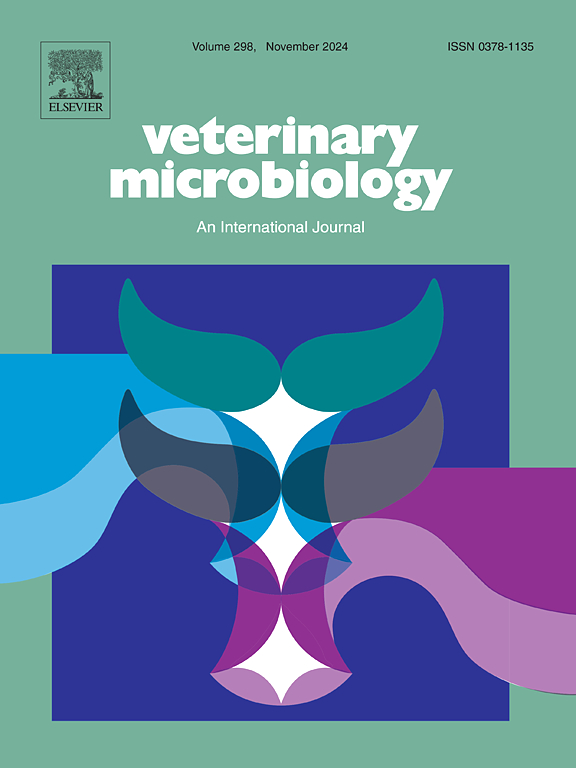蛋白质组学和抗氧化压力的调节参与了硝唑沙尼对日本脑炎病毒的体外抗病毒作用
IF 2.4
2区 农林科学
Q3 MICROBIOLOGY
引用次数: 0
摘要
日本脑炎病毒(JEV)是一种重要的流行性虫媒黄病毒,也是亚洲病毒性脑炎的主要病因。以前的研究表明,硝唑沙尼(NTZ)是一种抗寄生虫胃肠炎药物,属于噻唑类药物,在体外和体内对日本脑炎病毒均有疗效。为了探索潜在的抗病毒机制,我们采用了基于串联质量标签(TMT)的定量蛋白质组学方法来鉴定三组之间的差异表达蛋白(DEPs):空白细胞组、JEV 感染细胞组和经 NTZ 处理的 JEV 感染细胞组。我们的分析表明,NTZ 处理导致 JEV 感染细胞中 30 个 DEPs 上调,54 个 DEPs 下调。利用基因本体(GO)和京都基因组百科全书(KEGG)进行的富集分析表明,这些DEPs参与了多种生物过程和信号通路,包括转运、定位、对创伤的反应、P53通路激活和脂肪酸代谢相关通路。此外,我们还观察到与氧化还原稳态相关的蛋白质 TMX2 的表达趋势与基于 TMT 的定量蛋白质组学研究结果一致。对活性氧(ROS)、线粒体膜电位、抗氧化酶活性和 KEAP1-NRF2 通路的进一步研究表明,NTZ 能有效调节 KEAP1-NRF2 通路,同时抑制 JEV 感染诱导的氧化应激。总之,本文介绍的蛋白质组数据和抗氧化应激结果为进一步研究 NTZ 抗 JEV 的分子机制和潜在靶点提供了基础。本文章由计算机程序翻译,如有差异,请以英文原文为准。
The modulation of proteomics and antioxidant stress is involved in the effect of nitazoxanide against Japanese encephalitis virus in vitro
Japanese encephalitis virus (JEV) is a significant circulating arbovirus flavivirus and the primary cause of viral encephalitis in Asia. Previous studies have demonstrated that nitazoxanide (NTZ), an antiparasitic gastroenteritis medication classified as a thiazolide, exhibits efficacy against JEV both in vitro and in vivo. To explore the potential antiviral mechanisms, we employed Tandem Mass Tag (TMT)-based quantitative proteomics to identify differentially expressed proteins (DEPs) among three groups: Blank cell group, JEV-infected cell group, and JEV-infected cells treated with NTZ. Our analysis revealed that NTZ treatment led to the upregulation of 30 DEPs and downregulation of 54 DEPs in JEV-infected cells. Enrichment analysis using Gene Ontology (GO) and Kyoto Encyclopedia of Genes and Genomes (KEGG) indicated that these DEPs are involved in various biological processes and signaling pathways, including transport, localization, response to wounding, P53 pathway activation, and fatty acid metabolism-related pathways. Moreover, we observed that the expression trend of TMX2, a protein associated with redox homeostasis, was consistent with findings from TMT-based quantitative proteomics. Further investigations into reactive oxygen species (ROS), mitochondrial membrane potential, antioxidant enzyme activity, and the KEAP1-NRF2 pathway demonstrated that NTZ effectively regulates the KEAP1-NRF2 pathway while suppressing oxidative stress induced by JEV infection. In conclusion, the proteomic data along with antioxidant stress results presented herein provide a foundational basis for further research into the molecular mechanisms and potential targets of NTZ against JEV.
求助全文
通过发布文献求助,成功后即可免费获取论文全文。
去求助
来源期刊

Veterinary microbiology
农林科学-兽医学
CiteScore
5.90
自引率
6.10%
发文量
221
审稿时长
52 days
期刊介绍:
Veterinary Microbiology is concerned with microbial (bacterial, fungal, viral) diseases of domesticated vertebrate animals (livestock, companion animals, fur-bearing animals, game, poultry, fish) that supply food, other useful products or companionship. In addition, Microbial diseases of wild animals living in captivity, or as members of the feral fauna will also be considered if the infections are of interest because of their interrelation with humans (zoonoses) and/or domestic animals. Studies of antimicrobial resistance are also included, provided that the results represent a substantial advance in knowledge. Authors are strongly encouraged to read - prior to submission - the Editorials (''Scope or cope'' and ''Scope or cope II'') published previously in the journal. The Editors reserve the right to suggest submission to another journal for those papers which they feel would be more appropriate for consideration by that journal.
Original research papers of high quality and novelty on aspects of control, host response, molecular biology, pathogenesis, prevention, and treatment of microbial diseases of animals are published. Papers dealing primarily with immunology, epidemiology, molecular biology and antiviral or microbial agents will only be considered if they demonstrate a clear impact on a disease. Papers focusing solely on diagnostic techniques (such as another PCR protocol or ELISA) will not be published - focus should be on a microorganism and not on a particular technique. Papers only reporting microbial sequences, transcriptomics data, or proteomics data will not be considered unless the results represent a substantial advance in knowledge.
Drug trial papers will be considered if they have general application or significance. Papers on the identification of microorganisms will also be considered, but detailed taxonomic studies do not fall within the scope of the journal. Case reports will not be published, unless they have general application or contain novel aspects. Papers of geographically limited interest, which repeat what had been established elsewhere will not be considered. The readership of the journal is global.
 求助内容:
求助内容: 应助结果提醒方式:
应助结果提醒方式:


